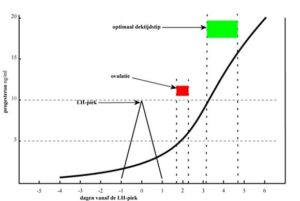The heat
A few days before the start of heat, the first signs are already visible. The following days are spent waiting for the expectant mother to start flowing. On average, a heat lasts three weeks. After about 12 days, a bitch can be mated. However, there is a wide difference in the day on which the bitch should actually be mated (there are examples of mating on the 5th day but also on the 20th day).
Progresterone determination
To determine the correct mating date, progresterone determinations are made. This is done using a blood test. A small amount of blood is taken and examined directly in the laboratory. The result of this test comes in a value. A low value <2.5 means that the bitch is in heat, but has not yet ovulated. Ovulation takes place somewhere between a value of 4 and 6. Mating only takes place after ovulation has occurred.
Coverage
When the progresterone level is high enough that the bitch can be mated (is ready for mating), we travel with the bitch to the male, sometimes we spend several days on the road for this. If the bitch is mated on the right day, one mating is sufficient. Nevertheless, more than one mating is usually done. During the mating, the male and female are coupled for some time; they are then attached to each other and cannot get loose due to the swelling of the male sex organ. This takes 20 minutes on average. During mating, you can see next to the male's tail that he is pumping and often you can see that the bitch regularly tightens her belly (contraction), thereby drawing the sperm towards her uterus.
First three weeks after mating
Sometimes in the first three weeks after mating, we see distinct changes in the expectant mother. For example, the look in their eyes may change and they sleep more than usual. Some bitches suffer from morning sickness and refuse to eat or even vomit. After about 10 days, some bitches are unwell for a day, the eggs are now nestling in the uterine wall.
The echo
Around the 28th day after mating, an ultrasound can be made to confirm the pregnancy. The vet can now also give a realistic estimate of the number of puppies the mother is carrying.
Belly starts to grow visibly
From the fourth week of pregnancy, the expectant mother's belly starts to grow visibly. In the beginning, this is still slow, but from the sixth week of pregnancy, the belly quickly grows larger and larger.
The last mile
Shortly before giving birth, bitches sleep a lot. 24 hours before the first pup is born, most bitches experience a temperature drop of at least 1 degree below the average body temperature. As labour slowly sets in, the bitch no longer wants to eat, starts panting and shows restless behaviour, especially digging in the whelping box. In nature, young animals are naturally born in a hole in the ground and this natural behaviour is still found in dogs.
The pups now move slowly from the abdominal cavity into the birth canal. A few hours, sometimes several dozen minutes, before the first pup is born, the expectant mother's membranes break and she loses amniotic fluid. The placement contractions will be replaced by push contractions. The bitch now pushes the first pup towards the exit of the birth canal.
Childbirth
Pups are viable from the 58th day. Pups leave the birth canal in both head and breech positions and are basically born in a membrane. It is important that this membrane is opened by the mother dog so that the pup gets oxygen. The mother dog will also bite through the umbilical cord. This is where the owner can offer assistance. A bitch expecting a large litter usually takes a break of one to several hours.
It depends on each bitch and breed how much time there is between the birth of each pup. If it takes too long, this is often a sign that the pup is not lying favourably and cannot pass through the birth canal. The vet then has to provide relief using contractions, retrieving the pup or even caesarean section. Immediately after giving birth, mother and pups need a lot of rest; a lot of physical effort has been made.

